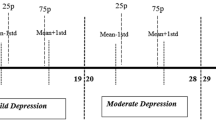Abstract
The objective of the study was to test the data quality, scaling assumptions and scoring algorithms underlying the electronic personal assessment questionnaire—pelvic floor (ePAQ-PF). A cross-sectional survey of 599 women with pelvic floor disorders was carried out. Tests of data quality included secondary factor analysis, internal reliability, descriptive statistics, levels of missing data, floor and ceiling effects, item-to-total correlation scores, item discriminant and convergent validity. Secondary factor analysis verified the domain structure of ePAQ-PF. All 19 domains were internally reliable with Cronbach’s α scores ranging from 0.71 to 0.93. Missing response rates ranged from 0.2% to 1.3%, and all items were found to be most highly correlated with their own corrected scale. Results confirmed the factor structure, data quality and scoring and scaling assumptions of ePAQ-PF, thereby verifying its suitability for measuring symptoms, bother and quality of life in women with pelvic floor disorders.

Similar content being viewed by others
References
Radley SC, Jones GL (2004) Measuring quality of life in urogynaecology. Br J Obstet Gynaecol 111(Suppl 1):33–36
Radley SC, Jones GL, Tanguy EA, Stevens VG, Nelson C, Mathers NJ (2006) Computer interviewing in urogynaecology: concept, development and psychometric testing of an electronic pelvic floor assessment questionnaire (ePAQ) in primary and secondary care. BJOG 113:231–238
Hägglund D, Walker-Engström ML, Larsson G, Leppert J (2003) Reasons why women with long-term urinary incontinence do not seek professional help: a cross-sectional population-based cohort study. Int Urogynecol J Pelvic Floor Dysfunct 14:296–304
Johanson JF, Lafferty J (1996) Epidemiology of fecal incontinence: the silent affliction. Am J Gastroenterol 91:33–36
Kosinski M, Keller SD, Hatoum HT, Kong SX, Ware JE (1999) The SF-36 Health Survey as a generic outcome measure in clinical trials of patients with osteoarthritis and rheumatoid arthritis: tests of data quality, scaling assumptions and score reliability. Med Care 37:MS10–MS22
McHorney CA, Ware JE, Lu JF, Sherbourne CD (1994) The MOS 36-item short-form health survey (SF-36): III. Tests of data quality, scaling assumptions, and reliability across diverse patient groups. Med Care 32:40–66
Kline P (2000) A psychometrics primer. Free Association, London
Rowan K (1994) Global questions and scores. In: Jenkinson C (ed) Measuring health and medical outcomes. UCL, London, pp 54–76
Bindman AB, Keane D, Lurie N (1990) Measuring health changes among severely ill patients: the floor phenomenon. Med Care 28:1142–1152
Gandek B, Ware JE, Aaronson NK, Alonso J, Apolone G, Bjorner J et al (1998) Tests of data quality, scaling assumptions, and reliability of the SF-36 in eleven countries: results from the IQOLA Project. International Quality of Life Assessment. J Clin Epidemiol 51:1149–1158
Oppenheim AN (1992) Questionnaire design, interviewing and attitude measurement: new edition. Continuum, London
Velikova G, Stark D, Selby P (1999) Quality of life instruments in oncology. Eur J Cancer 35:1571–1580
Streiner DL, Norman G (1995) Health measurement scales: a practical guide to their development and use, 2nd edn. Oxford University Press, Oxford
Cronbach LJ (1951) Coefficient alpha and the internal structure of tests. Psychometrika 22:293–296
Nunnally JC (1978) Psychometric theory. McGraw Hill, New Delhi
Campbell MJ, Machin D, Walters SJ (2007) Medical statistics: a textbook for health sciences, 4th edn. Wiley, Cichester
Ware JE, Brook RH, Williams KN, Stewart AL, Davies-Avery A (1980) Conceptualisation and measurement of health for adults in the Health Insurance Study: model of health and methodology, vol. 1. RAND, California
Jenkinson C, Levvy G, Fitzpatrick R, Garratt A (2000) The amyotrophic lateral sclerosis assessment questionnaire (ALSAQ-40): tests of data quality, score reliability and response rate in a survey of patients. J Neurol Sci 180:94–100
Jones G, Jenkinson C, Taylor N, Mills A, Kennedy S (2006) Measuring quality of life in women with endometriosis: tests of data quality, score reliability, response rate and scaling assumptions of the Endometriosis Health Profile Questionnaire. Hum Reprod 21:2686–2693
Stead ML, Crocombe WD, Fallowfield LJ, Selby P, Perren TJ, Garry R et al (1999) Sexual activity questionnaires in clinical trials: acceptability to patients with gynaecological disorders. Br J Obstet Gynaecol 106:50–54
Ammentorp J, Rasmussen AM, Nørgaard B, Kirketerp E, Kofoed PE (2007) Electronic questionnaires for measuring parent satisfaction and as a basis for quality improvement. Int J Qual Health Care 19:120–124
Kind P, Carr-Hill R (1987) The Nottingham Health Profile: a useful tool for epidemiologists? Soc Sci Med 25:905–910
Pauls RN, Silva WA, Rooney CM, Siddighi S, Kleeman SD, Dryfhout V et al (2007) Sexual function after vaginal surgery for pelvic organ prolapse and urinary incontinence. Am J Obstet Gynecol 197:622.e1–622.e7
Zullo MA, Plotti F, Calcagno M, Palaia I, Muzii L, Manci N et al (2005) Vaginal estrogen therapy and overactive bladder symptoms in postmenopausal patients after a tension-free vaginal tape procedure: a randomized clinical trial. Menopause 12:421–427
Kazis LE, Anderson JJ Meenan RF (1989) Effect sizes for interpreting changes in health status. Med Care 27:S178–S189
Acknowledgements
We are very grateful to the women who completed the questionnaire and gave consent for their data to be used in the study. We would also like to thank Mr. Andrew Farkas for his assistance with recruitment.
Conflicts of interest
G.L.J, J.L. and S.J. have no conflicts of interests to declare. S.C.R. is a director of EPAQ Systems, a newly formed NHS spin-out technology company.
Author information
Authors and Affiliations
Corresponding author
Rights and permissions
About this article
Cite this article
Jones, G.L., Radley, S.C., Lumb, J. et al. Electronic pelvic floor symptoms assessment: tests of data quality of ePAQ-PF. Int Urogynecol J 19, 1337–1347 (2008). https://doi.org/10.1007/s00192-008-0655-2
Received:
Accepted:
Published:
Issue Date:
DOI: https://doi.org/10.1007/s00192-008-0655-2




